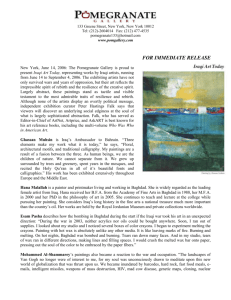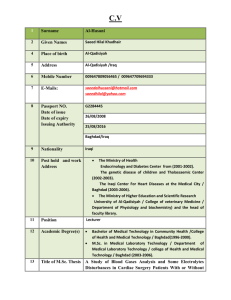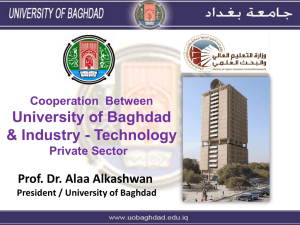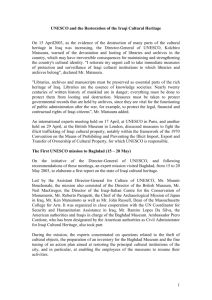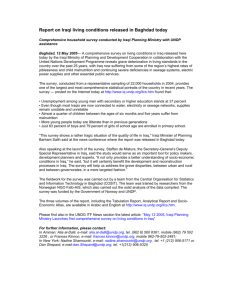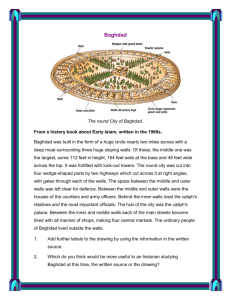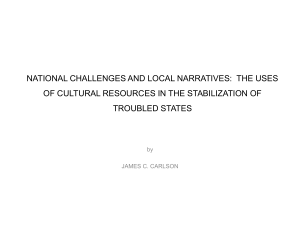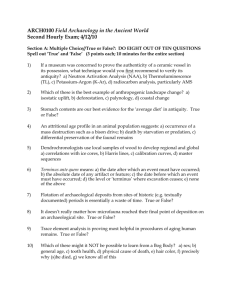Mission Report Iraq, 28.06-07.07.03
advertisement
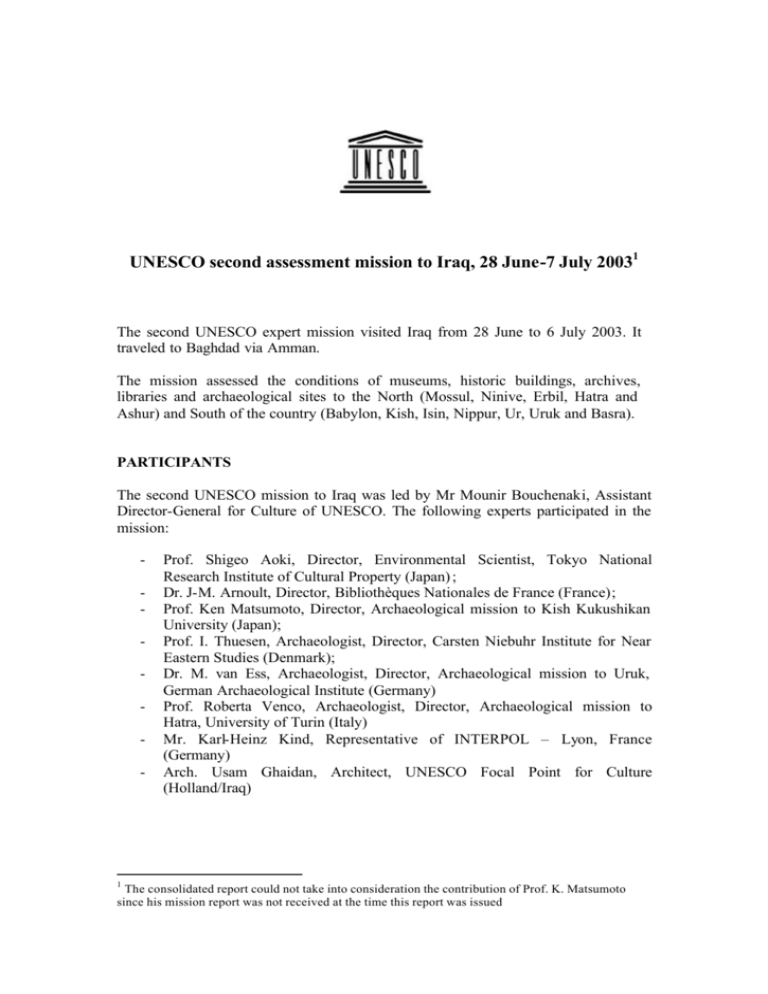
UNESCO second assessment mission to Iraq, 28 June-7 July 20031 The second UNESCO expert mission visited Iraq from 28 June to 6 July 2003. It traveled to Baghdad via Amman. The mission assessed the conditions of museums, historic buildings, archives, libraries and archaeological sites to the North (Mossul, Ninive, Erbil, Hatra and Ashur) and South of the country (Babylon, Kish, Isin, Nippur, Ur, Uruk and Basra). PARTICIPANTS The second UNESCO mission to Iraq was led by Mr Mounir Bouchenaki, Assistant Director-General for Culture of UNESCO. The following experts participated in the mission: - 1 Prof. Shigeo Aoki, Director, Environmental Scientist, Tokyo National Research Institute of Cultural Property (Japan) ; Dr. J-M. Arnoult, Director, Bibliothèques Nationales de France (France); Prof. Ken Matsumoto, Director, Archaeological mission to Kish Kukushikan University (Japan); Prof. I. Thuesen, Archaeologist, Director, Carsten Niebuhr Institute for Near Eastern Studies (Denmark); Dr. M. van Ess, Archaeologist, Director, Archaeological mission to Uruk, German Archaeological Institute (Germany) Prof. Roberta Venco, Archaeologist, Director, Archaeological mission to Hatra, University of Turin (Italy) Mr. Karl-Heinz Kind, Representative of INTERPOL – Lyon, France (Germany) Arch. Usam Ghaidan, Architect, UNESCO Focal Point for Culture (Holland/Iraq) The consolidated report could not take into consideration the contribution of Prof. K. Matsumoto since his mission report was not received at the time this report was issued ORGANIZATION OF THE MISSION The mission was organised in two groups: - Group A (Mr Aoki, Mr Arnoult) visiting museums, libraries and archives; - Group B (rest of the team) to visit archaeological sites and historic buildings. For security reasons except from Sunday 29 June and Thursday 3 July in the morning, the schedule of the team was the same for both groups. MISSION SCHEDULE The mission was scheduled as follows: June 27 Arrival to Amman June 28 Amman-Baghdad Meeting with Ambassador Cordone of the CPA June 29 Group A Baghdad: National Library, National Archives, Awqaf Library and Iraq Museum Group B Baghdad: Tell Harmal (ancient Shaduppu) and Tell Muhammad (ancient Diniktum) June 30 Uruk (modern Warka), was visited on the way from Baghdad to Basra. Due to a strong desert storm, the UNESCO team was not able to visit Larsa and was Ur (modern Tell Muqayyar) occupied by a military camp was seen from the outskirts. July 1 Basra : Central Public Library, University Central Library, Archaeological Museum, Folklore Museum, Natural History Museum and old quarter. Isin and Nippur were visited on the way to Baghdad 2 July 2 Group A Baghdad: National Library, Mosque and Centre for Manuscripts Group B Visit to Babylon, Hilla and Kish (modern Tell Uhaimir and Tell Ingharra). July 3 Baghdad: Iraqi Museum. The team attended the exhibition of the Nimrud Treasure Erbil July 4 Mosul: Old City, Library of the Museum, Central University Library Nineveh (modern Kouyounjik and Nebi Yunis) Hatra (modern Hadr) Assur (modern Sherqat). July 5 Meeting with Ambassador Cordone of the CPA Press conference Baghdad-Amman Press conference July 6 Departure from Amman AIM OF THE MISSION The mission aimed at: 1. Assessing the state of conservation of major archaeological sites in the country and accordingly prepare a prioritised plan of action including proposals for rescue interventions 2. Assessing the state of conservation of museums and cultural institutions outside Baghdad and accordingly prepare a prioritised plan of action including containing proposals for rescue interventions 3. Completing the assessment of the Iraqi Museum initiated during the first UNESCO expert mission, with regard to the conservation laboratories and storage areas to finalize a plan of interventions for the Iraqi Museum in Baghdad. 3 MEETINGS The team of UNESCO experts met twice with Ambassador Piero Cordone, Coalition Provisional Autority Coordinator for Cultural Heritage, and other representatives of the CPA. During the mission the Iraqi authorities were represented by Dr Muyad S. Damereji for the archaeology domain, and by Wishyar Muhammad for libraries and early archives. Meetings with Ambassador Piero Cordone First meeting on 28th of June On 28th of June, Ambassador Cordone received the team of UNESCO experts on their arrival. Mr. Fergus Muir from the British Foreign Ministry and a US liaison officer were also present. Mr. Bouchenaki explained the purpose of the mission and introduced its members. Ambassador Cordone presented an overview of the conditions of cultural heritage in Iraq and of the activities undertaken by different countries. Ambassador Cordone expressed the need of coordinating actions in Iraq. He also emphasised the severe security conditions, recalling that the day before one of his guards was shot on the street. Concerning the situation of the archaeological sites, Ambassador Cordone stated that the situation had improved. There were postings at sites and also regular patrols, for instance by helicopters. The CPA was in the process of paying more than 1200 guards to protect the sites against looting. Second meeting on 5th of July At the end of the mission, the UNESCO expert team reported on the results of the mission. It was mentioned that military presence on sites was a serious problem since the army units were not informed on the nature and complexity of the cultural landscape they were working in, as it was happening in Kish. Ambassador Cordone gave a list of sites to be protected/guarded, were sites already affected by looting were mentioned. The list mentions more than 100 important sites to be protected, 20 of them were the priority since looting already occurred. Ambassador Cordone was invited to participate in UNESCO Member States coordination meeting to be held in Paris on 16 July. The team met in Babylon on 2 July with Dr Helen McDonald from the University of Cambridge who was sent as coordinator of archaeological activities by the British Museum Meetings with Dr. Helen McDonald Dr. McDonald was posted in Babylon two weeks before the UNESCO visit at site, in order to assist in the rehabilitation of this site and also in the protection of archaeolo gical sites against looting in the South by the British authorities. During the meeting she expressed very deep concern for the situation. She was almost prevented from travelling in the countryside due to security problems and lack of military 4 presence. She also found her tasks almost impossible to achieve alone and without means. She also expressed her frustration over the way that salaries were paid by the CPA only to staff in Babylon but not outside it. She also informed the UNESCO team that Prof. Gibson of the University of Chicago, was trying to locate the looting by satellite images. She asked for a strong international and coordinated action on this matter. ASSESSMENT Iraqi Museum Laboratories The experts visited the laboratories with Ms. Buthaind Musalim Abdul Hassain, Head of the Restoration Section at the Iraqi Museum. Presently there are 11 people working in conservation. The laboratories are located on the second floor in 12 rooms. The conditions of the laboratories are as follows: 1. Office There are several desks and chairs. There are almost no documents left. 2. Chemistry Laboratory There are experiment tables around the walls; these are in a usable condition. In addition, there is also an atomic absorption spectrometer, a draft, a balance and other equipments. This room can be reused as a laboratory. 3. Physics Laboratory There is an ICP-MS, which seemed not to be frequently used. Laboratory equipments are in good condition but no expendable supplies could be found. 4. Geology Laboratory There is no ventilation system in the room. Experiment tables and fluorescent lights showed traces of corrosion caused by leaking of rain. Metallurgical microscope could not be found, either in this laboratory or in any of the other rooms. An abrasive machine and a chemical balance were found, but they were broken and cannot be used. There were also no expendable supplies for these apparatuses. 5. Fumigation Room There is a fumigation chamber of about 1m x 1m but fungi and insects are killed by natural vaporization of chemicals since there is no heating system. The ventilation pipe of the chamber is directly connected to the ventilation pipe of the draft. This means that there is a risk of toxic gas flowing into other rooms. 6. Clay Tablet Treatment Room There are 2 electric furnaces (about 1m x 1m) for firing clay tablets. There is also a draft and experiment tables, which are all usable. However, the furnaces are old and do not seem to have been used so often, so there is a possibility that the electric wiring may not be safe. It is probably better replaced by a new one that has a more accurate temperature control system. 5 7. Replica Manufacturing Room Manufacturing of replicas was a very important work at the Iraqi Museum. There are several tables along the walls and in the middle of the room as well as some completed plaster models and some more in the process of working. There is a small ventilator; it is too small, it seems, to be effective for a room of this size. Latex is used to make moulds; nothing else is used. Almost no other tools for making replicas were found. There is an apparatus for making distilled water but it seems not to be functioning. Three is a need to teach the staff new methods of making moulds and replicas. 8. Metal and Ceramics Restoration Laboratory Restoration of inorganic objects is conducting with focus on metals. The tables placed along the walls are made for chemical experiments. There is a dryer (about 1m x 1m), a draft and an apparatus for making pure water. It seems that the draft is used as a dust collector. No equipment for restoration could be found here but few chemicals. Although the draft is used when conducting treatments employing organic solvents, the lack of a ventilation system is a problem. Since the ventilation pipe of the draft is shared by other drafts, when one draft is used there is a risk of polluted air flowing into other rooms unless all the other drafts are used at the same time. 9. Chemicals store room Temperature of the store is so high that it is dangerous to have in organic solvents and other dangerous chemicals. There is one ventilator. The chemicals are placed on steel shelves but some of the chemicals are placed in chests with doors. It seems that this storage serves not only for chemicals but also for other materials. Organic solvents were also found but they are old and in need to be replaced. There is a potential danger since certain chemicals stored together might cause fire. 10. Organic Objects Restoration Laboratory This is a room with no window and no ventilation system. There are several tables for experiment along the walls. The room was used to treat wood, ivory and other organic objects, but the environment conditions were not suitable for such purpose. 11. Photography Room This room is not functioning and there is no equipment. There is only a sink in the processing laboratory; there are no chemicals or developing solution. It is too small for the purpose and at present it is used as storage. ARCHAEOLOGICAL SITES Despite serious security problems the team of UNESCO experts visited some of the most known archaeological areas, driving more than 3800 km from Baghdad to Basra to Erbil and Mosul. The assessment pointed out four types of “violations” of archaeological sites in Iraq, as a result of the events of wars, decades of sanctions and collapse of infrastructures: - looting and illicit digging 6 - military bases - accelerated decay - controversial reconstruction work Looting and illicit digging Looting in particular takes place in the central Southern region of Iraq, from Hilla in the North to Nasiriyah in the South. Around twenty important or named sites are documented to have been or are in the process of being looted. As observed at Nippur looting may soon develop on a day-to-day basis. There are reports of more hundreds of looters at sites such as Isin. The same site may be considered 50% lost and the same situation is reported in Adab (modern Bismaya). In particular medium to large sites and cemeteries seem to be targeted for looting, and also the looting technique appears similar. No assessment has been provided yet for the thousand of smaller tells existing in Iraq. Most digging is done with shovels and the team of UNESCO experts did not observe the use of heavy machinery such as bulldozers. Military bases Several sites have been used before and after the war for military bases and posts (i.e. Ur, Babylon and Kish). On the one hand, it can be said that the presence of military bases may have protected the site against looting, but army related activities might have caused damages as well (i.e. digging for the set up of a position; traffic with heavy armed vehicles, helicopters provoking vibrations, …). Another cause of damage is the lack of briefing to soldiers on the Iraqi cultural heritage identificatio n and urgent conservation issues. The following section describes the observed situation of the visited sites. Shaduppum / modern Tell Harmal The site is situated within the living quarters of New Baghdad in the South-Eastern part of modern Baghdad. A family (guard) is living on the site at the entrance gate. A fence encloses the site. The walls of the temples and administrative building and the lions (plaster copies) flanking the entrance are all intact and there are no signs of looting. The reconstructed double temples need some maintenance; the site in general needs cleaning and rehabilitation. Diniktum (?) / modern Tell Muhammad The site is located within the Baghdad city area. It could only be observed from the road as it had been used recently as a military post. A damaged fence surrounded the site. The site may contain munitions. Some digging around the sites does not seem to relate to looting, but rather to construction activities. Uruk / modern Warka It is one of the largest tells in the region located in the Governatorate of Muthanna. The excavations have only exposed approx. 4% of the whole area while the rest is 7 untouched. The site is well protected by a guard paid by the German expedition working on the site and the tribe of the at-Tobi living on it next to the expedition house. No lootings were visible or reported. Part of the excavated structures however suffer severely from erosion and should be consolidated as soon as possible. The White Temple and the Platform it rest on is in at an advanced stage of decay due to long exposure to extreme weather conditions. Ur / modern Tell Muqayyar Ur is located in the Governorate Dhi Qar, situated in the middle of a large military camp and airfield. The mission was not able to assess its state of preservation, but was worried about the potential risks occurring to the site within the military camp. Ur is famous for its best-preserved ziqqurrat, which needed some maintenance even before the recent armed conflict. The area of the private houses on the other hand, at first preserved up to a height of 2 meters, was in a very bad shape and urgently needed consolidation work. Isin / modern Ischan Bahriyat Located in the Governatorate of Qadisiya, on a flat plain in an uninhabited region. Is presently in alarming conditions. The UNESCO expert team visited the site very quickly guided by the former guard and foreman of the Isin excavation, because the looters were coming back. The site has been heavily looted since some years and will be destroyed completely if looting continues. It was estimated that 30-50 % of the site has been destroyed by illicit excavations and that looting has been carried out in such a bad way that the remaining buildings or structures are already deeply and irremediably affected. Protection of the site is a very urgent task and should be considered immediately. Nippur / modern Tell Nuffar The site is located in the Governatorate of Qadisiya. It has for more than a hundred years been under excavation by an American expedition. There was no longer a guard at the site, but the dig house is still there. Since excavations and maintenance of the excavated area were not possible for a long time, the exposed mud brick architecture suffered from erosion. Some weeks ago looting of the site started and has destroyed so far a major part of the outmost Northern tells of the city. At the small mound on the Northern fringe of the tell, about 50 to 100 holes have been observed. Babylon / modern Babil Babylon is the best-known and most famous ancient city of Iraq. The central part of the site is turned into a military camp. The expert team could not observe any damage to the site, which could be considered war related. However, the use of the area for a military base might have caused some problems in areas that the team did not visit. Indirect war-related problem is the controversial reconstruction of the NeoBabylonian palace on top of the ruins/foundations of the real buildings. For this reason the site has not been accepted on the UNESCO World Heritage List. Across the river on a huge artificial mound, Saddam Hussein built a monumental palace overlooking the site, but still within the city walls. The looting of the house and 8 administrative units of the Department of Antiquities seems to be the mo st pressing problem. All inventories, archives, electrical installations were gone. The museum had also been looted except for a large model of the site, but as the stolen objects were casts, the damage could not be considered serious. The CPA had already contracted a local constructor in order to have the damage in the small museum repaired. The site has been opened for tourism for “foreign” soldiers in Iraq. It was unclear whether or not the site was accessible to ordinary Iraqi people. Kish / modern Tell Uhaimir, Tell Ingharra Kish has been excavated during the last decades by a Japanese expedition. The site had been turned into an observation post by the US Military Police: a new fence of barbed wire surrounded this part of the tell and the UNESCO expert team was not allowed to enter it. Nineveh / modern Kouyounjik and Nebi Yunis It seems no guard is living permanently on the site. All exposed stone relieves from the Sennacherib palace as well as the slabs and winged bulls of the city gate and at Nebi Yunus are heavily damaged by erosion. They were produced out of Mosul marble or local limestone, both extremely fragile if exposed in open air. Protection roofs, installed by the State Board of Antiquities and Heritage had been stolen. In addition several parts of the stone relieves of Sennacherib palace were hammered off. In the Sennacherib palace it seems that several fragments of relieves disappeared. In particular, the ortostats standing in the corner on the left side of the entrance disappeared and several slabs have been damaged by looters. The missing slabs need to be identified on the basis of the already existing documentation. Hatra / modern Hadr Hatra, the firs Iraqi site inscribed on the UNESCO World heritage List (1985) did not show sign of looting. A sculpture head fallen down from a wall had apparently been stolen, but this event could not immediately be related to any war event. The site has a problem similar to the Babylon situation, as it has been heavily restored using dressed stones with the monogram of Saddam Hussein. A small team of five US soldiers presently patrols the site and is based in the Shahiru Temple causing damages to the area. Only authorised vehicles are allowed to access the themenos: a gate with a locker blocks the entrance and a guard controls this post. Within the buildings in the themenos, a female stone head from the decoration of the Small Iwan in the Great Iwan Complex disappeared, and a part of the right side of the bas-relief in the Allat Temple has been broken. Other damages could have been caused during the period of the embargo by blocking the entrances of some rooms of the Complex of great Iwans, by stonewalls. 9 Surface degradation has been noticed on the bas-relief of the Southern Iwan of the Allat Temple. There is an urgent need of conservation. Assur / modern Qalat Sherqat The site shows no recent damages. Some traces of unprofessional diggings may have been undertaken earlier. Earlier restorations of the palaces and some temples need maintenance but are still preserved enough to protect the original structures underneath. The site is endangered by the construction project of a dam some 40 km to the South. Due to the war the construction project was stopped. HISTORIC BUILDINGS The historical buildings of Iraq belong to two periods, late Abbasid and Ottoman. The former includes mosques, palaces, madrasahs (educational institutes), khans (caravanserais) and mausoleums. The latter is made up mainly of civic buildings. Bayt-al-Hikma in Baghdad This building began its life in 1721 as a madrasah, in 1938 it became the seat of Iraq’s first parliament and in1980 it was turned into a research institute and renamed the Palace of Culture. Just after the war, the building was burnt down and looted. All doors, windows, partitions, furniture, fixtures, fittings, air conditioners, false ceilings have been stolen. The Engineers of the Palace of Culture have prepared a detailed list of items of material and workmanship needed to rehabilitate the building fully. The estimate is of US$ 500 000. Abbasid Palace in Baghdad It was built as a school in 1230. It consists of 2-story blocks housing scholars’ rooms, lecture halls, common rooms, offices and service rooms, arranged around a square (20 m x 21.5 m) courtyard. The entrance door and the doorframe are stolen and the doorjamb is damaged. Al-Qushla in Baghdad A two-story structure erected along the Tigris in 1852.. Al- Qushla was used as government departments and was the first site of the National Museum. It was renovated in 1989. All the doors have been looted. The interiors of the offices are now exposed to the heat and humidity of the outside air, which is bound to damage the gypsum plaster of the offices. The clockwork has been stolen as well as most of the marble paving slabs from the floor of the portico. Al-Mustansiriyya School in Baghdad This is the site of one of the most famous Islamic universities. Its construction began in A.D. 1234 and was completed 7 years later. It is a two-story structure built of facing bricks and lime mortar. In 1946 large portions of its walls were rebuilt and the inner court was renewed, unfortunately not respecting the traditional materials and 10 techniques. In the mid-nineties another rehabilitation programme was carried out when a reinforced concrete flat roof replaced the barrel vault of the Western Iwan, which is completely alien to the architectural language of the building. Mausoleum of Sheikh Omar Al-Sahrawardi in Baghdad The tomb chamber is an octagonal prism covered by a conical pillar-shaped dome. The entire structure is constructed of facing bricks. Vertical cracks have developed on the South side of the pillar dome and some of the bricks show signs of early ballooning due to exposure to the elements. A structural appraisal of the structure should be undertaken. Repair should only be contemplated if it were found that the causes of the observed defects are still active. Town of Basra The town was subjected to repeated bombardments during the Iraq-Iran war. Damage after the recent war was extensive. The main libraries were burnt down completely. A fine building from the ‘British Raj’ period, built along the river-edge during the 1930’s and belonging to Basra University has been totally plundered and ruined. Several multi-story residential buildings situated along the Ashar creek are in a bad state of repair due to neglect and lack of maintenance. These are brick buildings with covered internal courts and projecting wooden balconies clad with delicate wooden lace-work (shanasheel). Town of Mossul Its most important development took place in the first half of the thirteenth century. The leaning minaret belonging to al-Nuri mosque that was built in 1172 should be noted. According to a study conducted by the University of Turin in 1967, the inclination is progressive and is caused by lack of adequate ties in the structure. The study proposes a method for the structural stabilization through a combination of piling and bored reinforcement bars. Beside the above the following cultural institutions were also visited: • School of Traditional Music This important institute has been totally plundered and the teaching programmes have come to a complete standstill. • National Heritage Centre This institute provides training for 120 boys and girls in traditional crafts. Damage caused to it by looters is relatively minor. UNESCO has allocated the sum of $25 000 to be used as seed money for its realization of a project document. This initiative received the support of the Coalition Provisional Aut hority. Town of Erbil The UNESCO expert team visited the citadel and some of the historical building. Here we found no traces of war related activities. In general Iraqi Kurdistan seems to 11 be in best shape and well functioning. Also no security problems were encountered in Erbil (i.e. no curfew). ARCHIVES AND LIBRARIES The following institutions have been assessed. in Baghdad: National Library, National Archives, Iraqi Centre for manuscripts, Awqaf Library and Mustansiriya University Library; in Basra: Central Public Library, Central University Library and Islamic Library; in Mosul: Public Central Library, Central University Library and Library of the Museum. Baghdad, Iraqi Centre for manuscripts The Centre for manuscripts, which has gathered a main part of Iraqi patrimony, is safe: the building is in a good state and has not been looted. During the latest years, the collection has been increased with a great number of small collections coming from different parts of the country; nowadays it has about 47 000 volumes. During the months before the conflict, the collection was transferred into a safe place in a secret shelter. The return and reinstallation of the collection in the previous premises is foreseen when the security is restored in Baghdad. The laboratory and restoration unit (situated in a small house close to the Centre) have been completely looted: there are only empty rooms left. Baghdad, National Library • Building The National Library has been severely damaged: the building (built in 1977) was burnt and looted twice, on April 14 and one week later. The ground floor with the main reading room has been sacked: catalogue cards pushed down on the floor, starts of fire of open access books in several places. The binding unit no longer exists. The first and visual acknowledgement is that the fire was well organised: books were gathered in some places and burnt with combustive agent so that they entirely burnt together with metallic shelves; it means that temperatures were high enough to destroy books and the structure of the building itself. The building is not guarded by the CPA. • Collections Before the war, it was already difficult to know precisely the number of volumes, the total fluctuating in function of the method used to describe periodicals (number of titles or number of issues). Nevertheless, it seems that, due to the potential of linear meters of shelves, the number of volumes ordinarily laying on the floor of the stores, the saturation of the stores and the common carelessness in the library, the figure of one million two hundred thousand volumes destroyed is a credible figure. 12 Between the first and the second fire (about one week), employees from the Library and volunteers moved a part of the collections to a Shiite Mosque in the former Saddam City and into a building of the Board of Tourism. At present, the collections are stored on three different sites: - About 700 000 volumes (rough estimation; the number of linear meters is not known) are still in the National Library About 300 000 volumes are stored in a mosque in Tawra Mosque: About 200 000 volumes seem to have been stored in a building of the Board of Tourism, in Baghdad Due to the embargo, only a small number of titles were recorded. No national bibliography was published. All the inventories are said to be destroyed by the fire or by vandalism. A part of the catalogue cards are still remaining in the drawers but an important part of the cards are lying on the floor. It is recommended to collect these cards together with documents dispersed in the building, to clean them cautiously and put them in baskets waiting for best times. Baghdad, National Archives The National Archives are located in the second floor of the National Library building. The same kind of fire has been used to ravage the service, destroying the collections, furniture and equipment. A part of the collection seems to have been moved in the same locations as the books of the National Library. It is difficult to know precisely which part of the collection has been destroyed and which part is safe. Inventories and catalogues available in the reading room and in technical services are said to be destroyed by fire. Baghdad, Awqaf Library Awqaf Library was totally destroyed by fire and probably looted. Only the outer walls are still standing. According to information collected abroad, the situation of the collection is as follow: about 40 % of the manuscripts must have been destroyed by fire and looting, as well as 90 % of the printed books. According to a visual evaluation, the building cannot be reused. Basra, Central Public Library The Central Public Library has been totally destroyed by fire, and probably looted before. Outer walls are still standing but concrete is deeply damaged by high temperatures. The method used is probably the same as in Baghdad: use of a specific fuel to activate fire and completely burn books and shelves. It seems difficult to restore the building. Basra, University Central Library The building of the University Central Library has been looted and vandalised: doors and windows were broken and smashed, as well as the equipment in the reading rooms and the technical services. Shelves, as well as tables and chairs, have been looted. The collections were gathered in some places of the library and burnt; about 75 % of the collections were destroyed. 13 Basra, Islamic Library This Library, depending on an association founded in 1950, is located in the old city of Basra. It was looted but not destroyed. The collection has been reconstituted by members of the association. It is now composed of about 400 printed books. Mosul, Central Public Library As the Library was closed by the time of the visit, only an outside assessment could be made. Apparently, the building presented some degradations (broken glasses, forced doors). But the inside of the Library, seen through the windows, looked in good condition: books seemed intact on shelves, furniture was still in place. Eventual looting had not disturbed the Library. Mosul, University Central Library The Central University Library, well located on the campus, was vandalised and looted (furniture, equipment and books), but not burnt. The building did not suffer in its structures as in Baghdad and in Basra. The appeals of religious authorities to return the stolen books made possible that only 30 % of books is lost. This Library was restored and it is functioning thanks to help and funds of US forces. Mosul, Library of the Museum Located in the basement of the Museum, the Library has been looted by specialists, as only important reference books (about 10) have been stolen. A start of fire is noticed in the reading room but without consequences for the Library. RECOMMENDATIONS The recommendations are listed according to order of priorities: Iraqi Museum Laboratories - Determine priorities and establish a rehabilitation plan Identify materials and equipment necessary to rehabilitate the laboratories Improve environmental conditions and facilities Establish restoration records Update documentation Train personnel Iraqi Museum - Provide proper environmental conditions in the display areas Provide proper environmental conditions in the storage areas Provide to the security of the building and collections 14 Archaeological sites Short-term actions: - UNESCO to urge CPA to stop looting of sites in Southern Iraq and the Diyala with all means. Actions may be of the following character: • • • • • • re-establish the traditional guard system by paying local guards and sheikhs provide regular and frequent inspections of sites promote the return of archaeologists to sites in order to re-establish good old practice locating and prosecution of professional dealers and syndicate of smugglers in Iraq and neighbouring countries stopping the open trade in Europe and America of artefacts looted from sites in Iraq brief the military forces in the region in order to wake their attention to the problem, i.e. by distributing pamphlets or folder describing the sites, artefacts and looting problems - Establish a salvage excavation campaign to rescue the remains of the sites that have been severely damaged by looting, such as Isin and Adab. - UNESCO to request military units to pay attention to archaeological sites and to avoid unnecessary posts being placed on top of tells, driving on tells with heavy vehicles, etc. - Organize seminars on focal problems of cultural heritage, such as appropriate restoration principles and techniques, as well as conservation issues - Protect exposed monuments and art, e.g. at Nineveh Middle- and long-term measures: - Facilitate to archaeological expeditions as soon as the infrastructure of the Department of Antiquities has been re-established - Prepare and coordinate an archaeological salvage project for the valley to be flooded in the region around Assur - Start conservation work of some major sites with excavated mud brick architecture, i.e. the White Temple at Uruk - Develop long-term internationally coordinated projects for research, protection and tourism for some of the major archaeological sites and monuments of Iraq 15 Libraries and Archives In general: - Find temporary buildings to host the collections Encourage personnel to resume work. Do not re- use buildings that have largely suffered and have been weakened Start reconstruction of collections Provide training of professionals In particular Baghdad, Centre for manuscripts - Avoid the return of the collection to Baghdad until the security situation is not stable Avoid the reinstallation of the collection in the previous location if these have not been restored correctly to warranty acceptable conditions of conservation. Prepare a preventive conservation programme Establish restoration and digitisation programmes Ensure training and qualification for technicians Baghdad, National Library - Make the collections secure in the different locations where they are Improve environmental conditions of temporary storage (mosque) Consider relocation of the National Library in new building Start cleaning and inventories Motivate employees and give them sense of responsibilities. Construct a new building and prepare its architectural programme. Provide to the inventory of collections to determine the programme of acquisitions to reconstitute destroyed collections. Organise urgently local training in the different fields of librarianship, including conservation (preventive conservation). Save what left at the National Library, try to clean it and keep it cautiously for later identification and re- use. Baghdad, National Archives - - Make the collections secure in the different locations where they are now. Improve conditions of temporary storage (mosque) Identify a safe and secure new building to gather the dispersed collections. Start the inventory of the remaining collections to replace lost inventories and catalogues. Start cleaning and boxing the remaining collections Start a programme for reorganisation of Iraqi archives, to collect and save what can be saved in the ministries and administrations, and try to reconstitute lost collections. Engage work to prepare construction of a new building, distinct of the National Library building. 16 Baghdad, Awqaf Library - Find a temporary location to gather the remaining collections, for cleaning and inventory. Prepare a programme of work to reconstitute the collections. Prepare an architectural programme to build new building. Prepare a training programme for employees (in conjunction with the National Library training programme). Basra, Central Public Library - Find a temporary location to install the Library. Acquire furniture and equipment. Acquire a new collection. Prepare an architectural programme to build a new Library. Basra, University Central Library - Make the building secure. Restore the building. Acquire furniture and equipment. Acquire a new collection. Mosul, University Central Library - Secure the building. Complete equipment and furniture. Acquire a new collection. Mosul, Library of the Museum - Acquire books to replace lost titles. Make building secure (together with the Museum). CLT/CH/ARB 17
